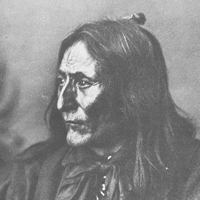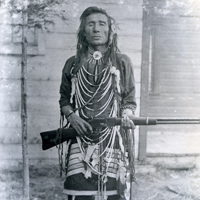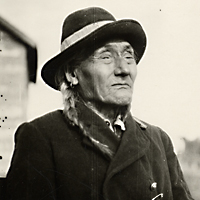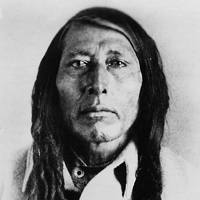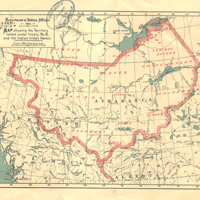Treaties: Negotiations and Rights
Note: there is a newer version of this essay available here
Author: Tamara StarblanketIntroduction
In what is now the Canadian state, eleven numbered agreements took place between Indigenous Peoples and the British Crown from 1870-1921. In contemporary times Treaty1 is greatly misunderstood from both Indigenous Peoples and non-Indigenous Peoples alike. What took place at these historical meetings has been a source of contention from the outset. The central issue is the land. Who had authority and jurisdiction over the land? What was agreed to in terms of the Treaty? Another issue is whether Indigenous Peoples signed away their right to govern themselves according to their laws and customs. The source of this contention is based on oral understandings versus the written understandings of Treaty. An explanation as to the reasons why Treaty is misunderstood is in the following quote:
The oral understanding of Treaty has not been taught in colonial mainstream education systems; instead the written version is supplanted as the only understanding. The oppression of the Elders' knowledge has only led to further ignorance on the subject of Treaty. The written version of Treaty leads to further ignorance as it is commonly understood that Indigenous Peoples ceded and surrendered the land over to the British Crown. This essay will discuss both Indigenous and Crown perspectives of Treaty. What did the negotiations conclude and what were the rights agreed to?
Before Treaty
Before Treaty, Indigenous Peoples' history starts from the Creation and the placement of Indigenous Peoples by the Creator on the lands now known as the North American continent.3 Oral understandings affirm that Indigenous Peoples have occupied their homelands since the beginning of time.4 Indigenous Nations are organized into different legal, political, economical and social societies and live according to the natural laws given by the Creator. Indigenous Peoples lives relate directly to their relationship with the land.5 Indigenous legal systems are intended to protect and honour the land.6 The land is fundamental to Indigenous legal systems. These systems were in place at the time the Crown representatives came to Indigenous Peoples' territories to make Treaty.
The Land Question
Before any discussion on Treaty can take place the issue of sovereignty must be addressed. A question worth posing is can land already occupied by peoples be discovered? An incorrect supposition held by many people is that Christopher Columbus discovered America; however, the reality is that "he sailed his ships into waters occupied and used by Indigenous Peoples."7 One of the beliefs held by Euro-Canadian society is that the territories and homelands occupied by Indigenous Peoples when the European explorers arrived were for the taking. This Eurocentric assumption that the land was for the taking is acknowledged by the Crown in current treaty discussion taking place in what is now Saskatchewan:
- It was widely assumed by Crown officials, that, prior to the treaties, the Crown was already sovereign over First Nations' traditional territories through unilateral assertion or through treaties with European powers.
- It was assumed, therefore, that the Crown had the power to extend its laws to First Nations.8
The unilateral assertion the Crown refers to is based on the belief that Britain had sovereignty over Indigenous Peoples' homelands, but how this came to be is an interesting question. In modern times a person cannot walk into a stranger's home and claim ownership of the house and the furnishings without committing a crime. What European explorers did at the time of contact and after was tantamount to walking into a person's home and taking possession of the house and the belongings.
Sharon Venne in her book entitled, Our Elders Understand Our Rights, discusses the impact the doctrine of discovery had on Indigenous Peoples and their legal systems. The Eurocentric view held by colonizing powers was that they were "bringing civilization and prosperity"9 to Indigenous Peoples. The doctrine of discovery justified European expansion into Indigenous Peoples territories without regard for the peoples and legal systems that had been in place since time immemorial. Venne argues, "this [Eurocentric] worldview dominated the formulation of European legal systems'" and this had the effect of
The British Crown came to the Treaty negotiations with the assumption that Crown sovereignty was paramount, whereas, the Indigenous Peoples under international law at the time had complete jurisdiction over the land and their way of life11.
Indigenous Understandings of Treaty
According to the Elders our rights are not granted by the Canadian Constitution instead it is bestowed upon us by the Creator and recognized by the making of Treaty.12 Indigenous rights are inherent.13 The inherent authority to governance cannot be granted by any foreign government. The United Nations Special Rapporteur on Treaties Miguel Alfonso Martinez determined that the Treaties negotiated and concluded with the British Crown are international agreements.14 This is the same understanding as our Elders. From an Indigenous worldview, Treaty reinforces the inherent authority. It is the legal framework that Indigenous Peoples operate from. The Elders understandings of Treaty are peace and friendship agreements not land surrender agreements.15 These peace and friendship agreements provide for two parallel legal systems that were intended to co-exist, each party respecting the authority of the other.
The Elders understanding of Treaty is that Indigenous Peoples were to continue on with their way of life with control over their way of life and the land and this knowledge is passed down orally.16 At the time of Treaty, Indigenous Peoples had full authority over their way of life and the land. When Treaty was negotiated Indigenous law was the law of the land and used by the Crown to conclude Treaties. For example, in 1876 when Treaty Six was negotiated and concluded it was Cree laws that guided the negotiation process:
In terms of the relationship, Treaty was negotiated and concluded between Indigenous Peoples and the British Crown on a nation-to-nation basis. Each party to the Treaty was to co-exist with neither one interfering with the other. In other words, to live in peace and friendship for as long as the sun shines and the waters flow.18 Treaties were not made with Canada.19 Canada as a treaty successor does not have the authority to alter Treaty without the consent of the Indigenous Peoples.20
Today, the government of Canada questions the original Spirit and Intent of Treaty. It is a very simple answer. Non-Indigenous People were granted the right to live in Indigenous Peoples' territories so long as they maintained peace and respected the land.21 In exchange Indigenous Peoples were to receive benefits such as health care and education.22 It is the oral understanding and not the written version that captures the original understanding of Treaty if the Spirit and Intent is to be understood. As one great warrior has stated, "Lies written down on paper do not make them true for anyone."23 The relationship was to be a parallel relationship neither party impeding or oppressing the other.
It becomes evident that the state of Canada has violated the terms of the Treaty by relying and imposing the written version of Treaty. Perhaps the main issue with the Crown's understanding is how they came to acquire underlying title over Indigenous Peoples territories and natural resources. The imposition of Crown sovereignty reflects the earlier discussion pertaining to the doctrine of discovery. How can the Crown claim title to lands that they did not own in the first place?
Crown's Understanding of Treaty
The Crown came to Indigenous Peoples with the Eurocentric assumption they already had sovereignty over Indigenous Peoples and their lands and resources. This is evident in the land transfer that took place between the Hudson Bay Company and the colonial government in July 1689.24 Indigenous Peoples at the time questioned this transfer of land:
The transfer of land from the Hudson Bay Company to the Crown is fraudulent. The Hudson Bay Company was a trading company and how they came to have ownership over Indigenous lands is suspicious: "In present circumstances, it would be tantamount to Pepsi Cola or another such company gaining title to the lands of another country merely by engaging in trading."26
How did the Crown have the authority to legislate control over the land and Indigenous Peoples? According to the current discussion about treaty implementation in what is now Saskatchewan, the colonial government's authority was granted by virtue of the Royal Proclamation, 1763, which established the following:
- Recognized that First Nations had rights in their lands;
- Established imperial control over settlement on Indian lands whether those lands were within the boundaries of the established British colonies of North America;
- Prohibited private purchase of Indian lands and required that alienation of Indian rights in Their lands by way of surrender to the Crown; and
- Established a process by which surrender of Indian land would be made to the Crown....27
The language expressed operates from the basis that the colonial government already had underlying title or sovereignty? How did Crown establish control over Indigenous lands without the consent of the Indigenous Peoples affected? By an enacted piece of legislation the British Imperial Crown has complete jurisdiction just because they say so? According to the Indigenous understanding the Royal Proclamation affirmed their nation-hood:
Another important aspect to the Indigenous understanding is that the Royal Proclamation did not bind Indigenous Peoples; in fact the British Crown was bound to follow certain rules with respect to Indigenous peoples and their territories.29 The Royal Proclamation was a "codification of the norms of customary international law for entering into treaties. International law required that a sovereign enter into formal agreements with another people's sovereign prior to entering lands occupied by those peoples."30
How does the issue of supposed Crown title relate to the doctrine of discovery? The British Crown contends that the land was ceded and surrendered by the Indigenous Peoples at the time Treaty was negotiated. Why does the Crown perpetuate this understanding? According to Venne, the doctrine of discovery justified the imposition of Crown title without the consent of the Indigenous nations. She states: "because of the doctrine of discovery, treaties with Indigenous nations did not ensure a place for Indigenous Peoples within the family of nations under international law. The discovery doctrine allowed competing European powers to define their respective sphere of influence in the colonies."31 If Crown sovereignty is based on this fictitious doctrine then what does this say about Treaty? In other words, one party cannot come to a treaty making process with the flawed belief that they have sovereignty over another nation's territory without that nations consent. The Crown came to the treaty negotiations with the belief that Crown title was supreme without legitimizing their sovereignty. However, the reality was under international law the Europeans were "establishing formal legal relationships with indigenous North Americans, the European parties were absolutely clear about a very important fact; namely, that they were indeed negotiating and entering into contractual relations with sovereign nations, with all the legal implications that such a term had at that time in international law."32 It becomes clear that the Crown was operating in a deceitful manner.
Negotiations and Rights
What are the negotiations and rights that were agree to? This depends on which worldview this understanding comes from. Historically and in modern times the government of Canada, retains the view that Crown sovereignty is paramount when discussions about treaty implementation take place. In most numbered treaty agreements the Crown assumed that they were granting land to Indigenous Peoples because of the assumption that title was already solidified.33 The Royal Proclamation set out the treaty process that was to take place between the Indigenous Peoples and the Crown. The Crown's intent for negotiating the numbered treaties is summarized in Treaty Implementation: Fulfilling the Covenant as follows:
The Crown's intent was to clear Indian title to the land and in exchange for clearing Indian title:
It becomes apparent from the preceding quotes that the Crown believed they had exclusive title and that they were granting Indigenous Peoples certain rights. This Eurocentric assumption begs a very important question. Who gave the Crown the authority to grant rights that did not belong to them? The truth of the matter is that Indigenous nations were organized for thousands of years prior to the arrival of European settlers and that their arrival into Indigenous Peoples territories did not grant them privilege or control over the territories occupied by Indigenous Peoples. The arrival of Europeans on the shores of what is now the North American continent did not magically trump the inherent authority that Indigenous Peoples possessed and still possess.
The Elders understanding of Treaty is simple. The Crown came to Indigenous Peoples territories asking for rights to share the land. Indigenous Peoples did not go to the Crown asking for land rights.36 The Elders are adamant that Treaty is an international agreement between sovereign nations. The agreements concluded were peace and friendship agreements. The agreements concluded were not cede and surrender agreements. According to the Indigenous understanding:
What rights were granted to the British Crown? The Elders understand that the Crown was granted rights to live in Indigenous Peoples territories (share the land) as long as the Crown respected the land and lived in peace with the Indigenous Peoples.38 The mountains, water, animals, birds, minerals and forests were not for negotiation.39 These still belong to Indigenous Peoples to protect and no agreement can ever take that responsibility away despite the underhandedness apparent in Crown dealings with Indigenous Peoples.
Conclusion
It is apparent from the discussion that the understandings of Treaty are divergent. It would be difficult to determine what rights were agreed to if one party comes to the negotiations with the Eurocentric assumption that they have control over the negotiations. What about the land? The Crown did not have underlying title or sovereignty despite what their imposed legal systems say about the matter. Indigenous Peoples have existed in what is now the North American continent for thousands of years or since the beginning of time. Indigenous Peoples have not violated the terms of the Treaty but time and time again the Crown abuses the land through their resource development projects and imposes their laws.
Pertaining to the question of authority and governance, Indigenous Peoples possess the inherent authority to determine their own laws and customs, despite one party holding the Eurocentric assumption they have supreme law on a continent that they did not discover.
Notes
1. From an Indigenous worldview Treaty is the preferred term to use when making reference to Treaties 1-11. L. back
2. Sharon H. Venne, "Understanding Treaty 6: An Indigenous Perspective" in M. Asch, ed., Aboriginal and Treaty Rights in Canada (Vancouver: UBC Press, 2002) at 173. back
3. H. Cardinal & W. Hilderbrandt, Treaty Elders of Saskatchewan: Our Dream is that Our Peoples Will One Day Be Clearly Recognized as Nations (Calgary: University of Calgary Press, 2000) at 5. back
6. Sharon H. Venne,"Treaties Made in Good Faith" in Native and Settlers—Now and Then (Edmonton: University of Alberta Press, 2007) at 2. back
7. Sharon H. Venne, Our Elders Understand our Rights: Evolving International Law Regarding Indigenous Peoples (Penticton, British Columbia: Theytus Books Ltd., 1998) at 1. back
8. Office of the Treaty Commissioner, Treaty Implementation: Fulfilling the Covenant, (OTC: Saskatoon, 2007) at 22. back
11. Isabelle Schulte-Tenckhoff, "The United Nations Study on Treaties, Agreements and other Constructive Arrangement" in Honour Bound: Onion Lake and the Spirit of Treaty Six: The International Validity of Treaties with Indigenous Peoples (IWGIA: Copenhagen, 1997) at 14. back
12. See generally H. Cardinal & W. Hilderbrandt, Treaty Elders of Saskatchewan: Our Dream is that Our Peoples Will One Day be Clearly Recognized as Nations (Calgary: University of Calgary Press, 2000). back
13. From an Indigenous perspective, "inherent" means ownership and jurisdiction over lands, resources and the laws of Indigenous Peoples. It is the inherent right to of all Peoples to determine their own distinct laws, traditions and systems of governance. The term inherent means a right that cannot be transferred or surrendered, also called an inalienable right. back
14. See generally Miguel Alfonso-Martinez, Special rapport-eur), Final Repot: Human Rights of Indigenous People Study on Treaties,, agreements and other constructive arrangements between States and indigenous populations, UN Commission on Human Rights, 1999, E/CN.4/Sub 2/1999/20 back
19. According to Sharon Venne, the Elders are correct in their understanding of Treaty being an international agreement. Colonial governments could not enter into treaties without the authority of the Parliament that created them. Canada did not have the authority to enter into treaties in its own right until the Statute of Westminster in 1932. Canada could not become a party to the treaty without the consent of both parties. The Indigenous Peoples never gave their consent to Canada to be a party to the treaty, and Canada did not sign Treaty 6. back
20. Supra note 6 at 9. See also Miguel Alfonso-Martinez, Special rapport-eur), Final Report: Human Rights of Indigenous People Study on Treaties,, agreements and other constructive arrangements between States and indigenous populations, UN Commission on Human Rights, 1999, E/CN.4/Sub 2/1999/20. back
22. For a detailed analysis please see Sharon Venne's paper entitled "Understanding Treaty Six" for a detailed account of the things promised to Indigenous Peoples under Treaty. (Note 2) back
24. Wayne E. Daugherty, Treaty Research Report Treaty One and Treaty Two (1871) , (Ottawa: Treaties and Historical Research Centre Research Branch, Corporate Policy: Indian and Northern Affairs Canada, 1983) at 3 Online: http://www.ainc-inac.gc.ca/pr/trts/hti/t1-2/tre1-2_e.pdf back
36. See generally Sharon H. Venne, "Treaties Made in Good Faith" in Native and Settlers—Now and Then (Edmonton: University of Alberta Press, 2007). back

